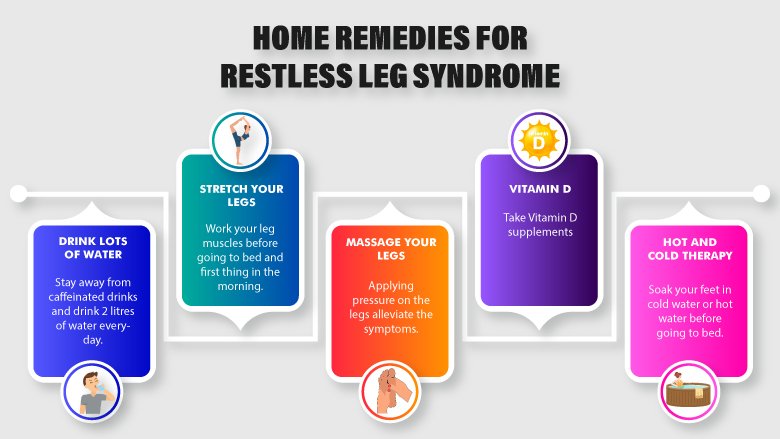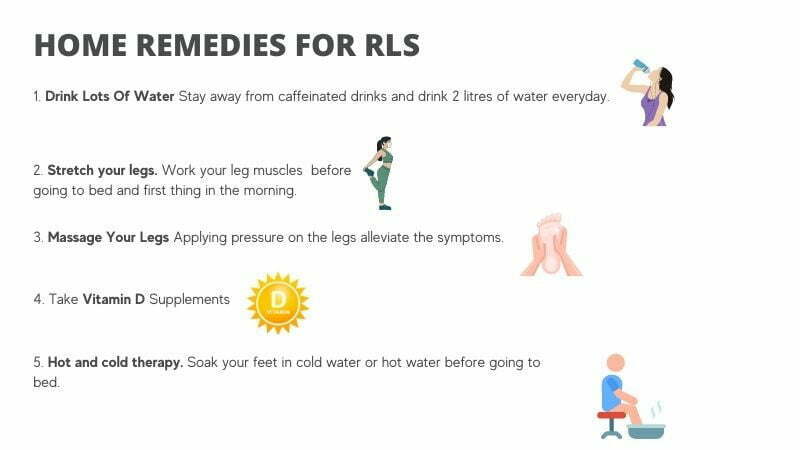Discover the secret remedies for restless leg syndrome that will have you kicking discomfort to the curb in no time.
Table of Contents
- Introduction to Restless Leg Syndrome
- What Causes Restless Legs?
- Foods that Might Help
- Exercises for Easing Restless Legs
- Bedtime Tips for Calmer Legs
- Ways to Keep Your Legs Happy During the Day
- Visiting the Doctor
- How to Explain Restless Legs to Friends
- Tools and Gadgets That Can Help
- Conclusion: Taking Care of Your Leg Wiggles
- FAQs: Questions Kids Might Ask
Introduction to Restless Leg Syndrome
Have you ever experienced that weird feeling in your legs, like they just won’t stay still, especially when you’re trying to relax or sleep? This sensation can be quite uncomfortable and irritating, and it’s actually called restless leg syndrome.
Restless leg syndrome, or RLS for short, is when your legs seem to have a mind of their own, making you feel like you need to move them constantly. It’s like your legs are trying to find a more comfortable position, but nothing seems to work. This can be frustrating, especially when you’re trying to rest or fall asleep.
But fret not, there are ways to soothe your restless legs and make them feel better so you can get some much-needed rest. Let’s explore some tips and tricks to help calm your legs and improve your sleep quality.
What Causes Restless Legs?
Restless leg syndrome can be quite a mystery, but there are some reasons that might explain why your legs just can’t seem to stay still. Two common factors that might contribute to this wiggly sensation are iron deficiency and sleep apnea.
Lack of Iron
Iron is a super important mineral that helps your body make lots of good stuff like healthy blood cells. When you don’t have enough iron in your body, your legs might feel like they need to move around all the time. So, it’s like your legs are saying, “Hey! I need more iron to stay calm!”
Trouble with Sleep
Now, imagine if you can’t sleep well at night because of something like sleep apnea, which is a condition where you have trouble breathing while you’re snoozing. This lack of deep and restful sleep can sometimes cause your legs to feel restless during the day. It’s like they’re trying to wake you up and stretch out because they didn’t get enough rest during the night.
Foods that Might Help
When your legs feel weird and restless, eating the right foods can make a big difference. Foods rich in omega 3, magnesium benefits, and iron can help soothe those wiggles and make your legs feel more comfortable.

Image courtesy of www.novomedshop.com via Google Images
Omega 3 Friends
Foods like salmon, tuna, and flaxseeds are packed with omega 3. These healthy fats can calm down your legs and make them feel less jumpy. Try adding more of these foods to your meals to see if they help.
Magnificent Magnesium
Magnesium is a mineral that is super good for your body. It can relax your muscles, including the ones in your legs. Eating foods like nuts, seeds, and whole grains can give you a good dose of magnesium to help ease those restless leg feelings.
Iron Power-Up
If you’re feeling extra wiggly, it might be because you’re low on iron. Iron is important for keeping your legs and body strong. Eating foods like lean meats, beans, and leafy greens can boost your iron levels and give your legs the power they need to stay still.
Exercises for Easing Restless Legs
When your legs feel restless and fidgety, doing some simple exercises can help calm them down. These exercises are fun and easy to do, and they can make a big difference in how your legs feel. Let’s dive into some exercises that can help ease your restless legs!
Stretching Out
If your legs won’t stay still, try some gentle stretches to relax your muscles. Stretching can help your legs feel less jittery. Here’s a quick stretch you can do:
1. Sit on the floor with your legs straight out in front of you.
2. Reach towards your toes and hold for 10-15 seconds.
3. Slowly release and repeat a few times.
Stretching your legs gently can help release tension and make them feel more comfortable. Remember, always listen to your body and don’t force any movements that cause pain.
Being Careful with Knee Pain
If you experience knee pain while doing exercises, it’s essential to be cautious and gentle with your movements. Here are some tips to help you manage knee pain while easing restless legs:
1. Avoid exercises that put too much pressure on your knees, like jumping or deep squats.
2. Stick to low-impact exercises, such as walking or swimming, that are easier on your joints.
3. Use proper form and technique while exercising to prevent straining your knees.
Remember, if you have persistent knee pain, it’s crucial to consult with a healthcare provider before continuing any exercise routine.
Bedtime Tips for Calmer Legs
Restless leg syndrome and sleep apnea can make it hard for your legs to stay still at night. Here are some tips to help calm your legs before bedtime:

Image courtesy of www.novomedshop.com via Google Images
Relaxing Routine
Before bed, try to relax your legs by doing gentle stretches or taking deep breaths. You can also try reading a book or listening to calming music to help your body unwind.
Bed Set-Up
Make your bed a cozy place for your legs. Adding pillows under your knees or using a weighted blanket can provide extra comfort and support. Creating a soothing environment can also help your legs feel more at ease.
Ways to Keep Your Legs Happy During the Day
Restless leg syndrome can make your legs feel fidgety and uncomfortable, especially during the day while you’re sitting in school or at home. But there are some simple ways to help keep your legs happy and calm.
Moving Breaks
It’s important to remember to take short breaks throughout the day to stand up and move around. This can help keep your legs from getting too restless and give them a chance to stretch and relax. Try taking a short walk, doing some light exercises, or simply standing up and stretching at your desk. Even a quick dance party in your room can be a fun way to keep your legs moving and happy.
| Tip | Description |
|---|---|
| 1 | Elevate your legs |
| 2 | Apply a cooling gel or lotion |
| 3 | Take a warm bath before bed |
| 4 | Avoid caffeine and alcohol before bedtime |
| 5 | Practice relaxation techniques such as deep breathing or meditation |
Fun Leg Games
You can also play games with your legs to help keep them happy and distracted. Try tapping your feet to the beat of your favorite song, or see how high you can lift your knees while sitting in your chair. You can even practice spelling out words with your toes on the floor. These games can be a fun way to keep your legs occupied and prevent them from feeling too restless.
Visiting the Doctor
When you’ve tried everything to calm your restless legs and they still won’t stay still, it might be time to visit the doctor. Don’t worry! The doctor is there to help you feel better. Here’s how you can talk to your doctor about your restless leg syndrome and what tests they might do to figure out what’s going on.

Image courtesy of www.australiawidefirstaid.com.au via Google Images
Talking About Your Legs
When you go to the doctor, it’s important to tell them exactly how your legs feel. You can say something like, “My legs never want to stay still, and it makes it hard for me to relax.” Talking about your symptoms will help the doctor understand what you’re going through and how they can help.
Tests You Might Take
Your doctor might want to do some tests to find out why your legs are restless. One common test is checking your iron levels. If you don’t have enough iron in your body, it could be causing your legs to feel fidgety. Don’t worry, these tests are simple and painless, and they will help the doctor find the best way to help you feel better.
How to Explain Restless Legs to Friends
When your legs feel restless and you need to move them around a lot, it can be hard to explain to your friends why you’re always fidgeting. Here are some simple ideas on how to share what’s going on with your legs in a way that they can understand.
Sharing Your Story
One way to tell your friends about your restless legs is to explain that sometimes your legs feel funny or uncomfortable, and moving them helps you feel better. You can compare it to when they have an itch that won’t go away until they scratch it. Let them know that it’s not something you can control and that it’s just your body feeling restless.
It might be helpful to use simple words and phrases like “My legs feel jumpy, and I need to stretch them to feel more comfortable,” so your friends can grasp the basic idea without getting confused.
Tools and Gadgets That Can Help
When dealing with restless leg syndrome, there are various tools and gadgets that can provide relief and help you feel more comfortable. These items are designed to support your legs and keep them calm, making it easier for you to relax and get some rest. Let’s explore some of these helpful tools below.

Image courtesy of fibromyalgia.newlifeoutlook.com via Google Images
Leg Comforters
If you have restless legs, using leg comforters can be a great way to soothe them. These leg cushions or pillows are specially designed to provide support and alleviate discomfort. Placing a leg comforter under your legs while sitting or lying down can help reduce the urge to constantly move and fidget. They can also promote better circulation and help you relax more easily.
Restless Leg Toys
Another option to consider is using restless leg toys or gadgets. These items are specifically designed to distract your legs and provide sensory stimulation that can help calm your muscles. You can choose from various toys such as stress balls, fidget spinners, or sensory cushions that allow you to focus on something other than the urge to move your legs. By keeping your hands and mind busy, these toys can help reduce the discomfort associated with restless leg syndrome.
Conclusion: Taking Care of Your Leg Wiggles
Keeping your legs happy and content is essential to feeling comfortable and relaxed throughout the day. By incorporating some simple tips into your routine, you can effectively manage restless leg syndrome and minimize any discomfort you may experience.
Remember to focus on incorporating foods rich in omega-3, magnesium, and iron into your diet to promote overall leg health. These nutrients can play a crucial role in keeping your legs calm and relaxed.
Additionally, engaging in regular stretching exercises can help ease any restlessness in your legs and improve flexibility. Just be sure to be mindful of any knee pain and adjust your exercises accordingly to avoid discomfort.
Creating a relaxing bedtime routine can also contribute to a more restful night’s sleep. By establishing a calming environment and preparing your legs for rest, you can reduce the likelihood of experiencing restless leg symptoms during the night.
Throughout the day, be sure to take movement breaks and engage in fun leg games to keep your legs active and prevent excessive fidgeting. Incorporating these activities into your daily routine can help manage restless leg syndrome and keep your legs happy.
And finally, if you find that your restless leg symptoms persist or worsen, don’t hesitate to speak with a healthcare provider. They can offer additional guidance and support to help you effectively manage your condition.
FAQs: Questions Kids Might Ask
Why do my legs want to move on their own?
Hey there! If your legs feel like they have a mind of their own, it could be because of something called restless leg syndrome. Sometimes, your legs might need to move because they’re not getting enough rest while you’re trying to settle down and relax. It can make them feel funny and uncomfortable, like they’re fidgety and won’t stay still. So, when you feel the urge to move your legs, it’s your body’s way of trying to get comfortable and find some relief.
Can I still play sports if I have restless legs?
Absolutely! Having restless legs doesn’t mean you have to give up playing your favorite sports or being active. In fact, staying active and moving around can actually help improve restless leg syndrome. Just make sure to balance your physical activities with some rest and relaxation time to give your legs the break they need. It’s all about finding the right mix of fun activities and calm moments to keep your legs happy and healthy.
Will my restless legs ever go away?
Restless leg syndrome can be different for everyone, but the good news is that there are things you can do to help manage and ease the feelings of restlessness in your legs. By making some changes to your lifestyle, like eating nutritious foods, getting enough sleep, and staying active, you can improve your symptoms and make your legs feel better. While there may not be a quick fix, with time and the right habits, you can learn to keep your legs happy and peaceful.





